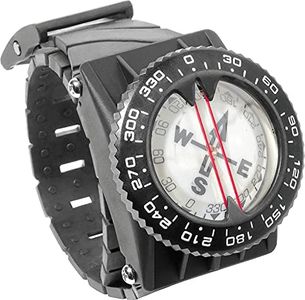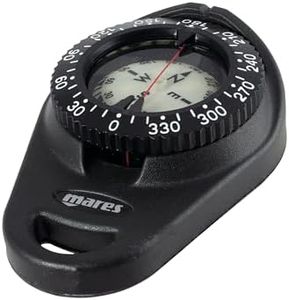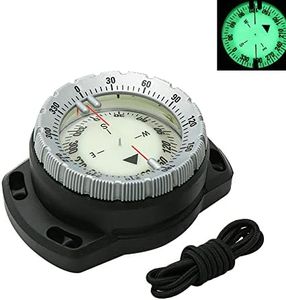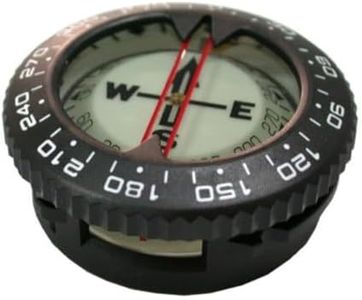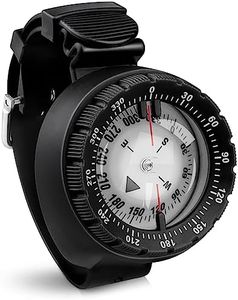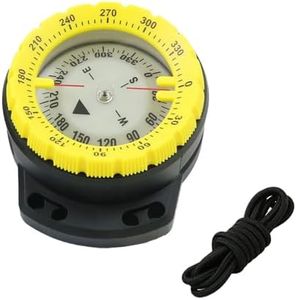We Use CookiesWe use cookies to enhance the security, performance,
functionality and for analytical and promotional activities. By continuing to browse this site you
are agreeing to our privacy policy
10 Best Underwater Compass For Scuba Diving
From leading brands and best sellers available on the web.Buying Guide for the Best Underwater Compass For Scuba Diving
Choosing the right underwater compass for scuba diving is essential for safe and enjoyable dives, especially when exploring unfamiliar or complex environments. A good diving compass helps you maintain your sense of direction underwater, where it’s easy to get disoriented. When picking an underwater compass, you should focus on certain key specs and features that influence ease of use, accuracy, and reliability in underwater conditions. Think about your typical dive environments, how you prefer to attach or carry your compass, and your level of diving experience as guiding points in your selection.Compass TypeUnderwater compasses generally come in either wrist-mounted, console-mounted, or clip-on forms. Compass type refers to how the device is attached to your gear or body. Wrist-mounted compasses are worn like a watch and are convenient for quick glances and ease of access. Console-mounted compasses are integrated into your gauge console, often alongside depth or pressure gauges, keeping essential instruments together but sometimes requiring you to hold up the entire console to read. Clip-on versions can attach to a D-ring or BCD strap for flexible positioning. Your choice should be guided by your preferred way of managing your equipment and how often you anticipate checking your compass during dives.
Lubrication and Tilt ToleranceA good diving compass uses liquid filling (often oil or fluid) to stabilize the needle and reduce vibration, which helps with easy reading underwater. Tilt tolerance means how much you can angle the compass and still get an accurate reading—higher tilt tolerance makes the compass more forgiving if it’s not held perfectly level. Tilt tolerance values vary, with basic models sometimes requiring flat positioning, while better-quality ones allow a tilt of 15-30 degrees or more. If you want hassle-free operation and anticipate using the compass in various diving positions, look for a model with generous tilt tolerance.
LuminescenceLuminescence determines how well the compass can be read in low light or murky water, vital for night dives or deep exploration. Some compasses have glow-in-the-dark markings or built-in illumination. The quality and duration of luminosity matter: a compass that glows brightly and for a long time after charging under a light source is more useful for extended or nighttime dives. If you frequently dive in environments with poor light, prioritize a compass with strong, long-lasting luminescence.
Bezel DesignThe bezel is the rotating ring that you use to mark bearings. A well-designed bezel should be easy to grip and turn with gloves on, offer positive clicks or detents for accuracy, and have clear, readable markings. Some bezels rotate 360 degrees smoothly, and others may have degree markings or cardinal points (N, E, S, W) for easier navigation. If you expect to adjust your course often or dive with gloves, a bezel that's large and easy to manipulate is advisable.
Size and LegibilitySize and legibility refer to the compass face's diameter and how readable the numbers and markings are underwater. A larger compass face is often easier to read, particularly with a mask on. Markings should be bold and high-contrast to make quick reads easier in challenging conditions. Choose a size that balances readability with comfort—larger is better for legibility, but make sure it fits your wrist or gear without being cumbersome.
Durability and Build QualitySince diving is tough on gear, durability encompasses the compass’s resistance to pressure, saltwater corrosion, impacts, and scratches. Look for a solid, well-sealed case and robust attachment points. A high-quality compass should withstand repeated immersion and potential knocks against rocks or gear. If you dive in rougher environments or travel a lot, prioritize models known for ruggedness and a strong protective case.

